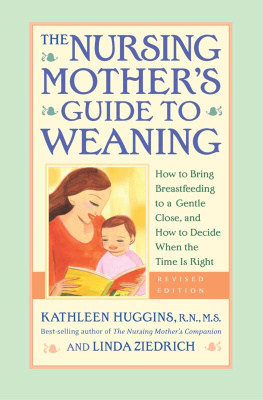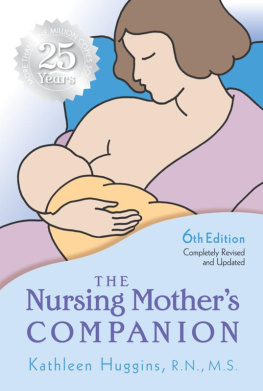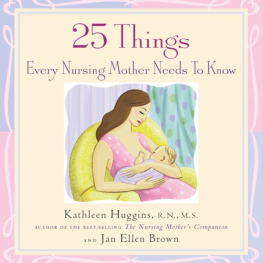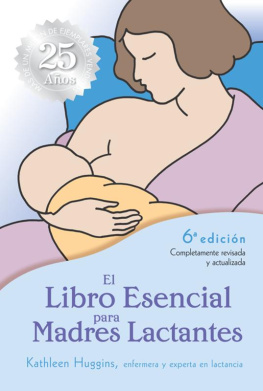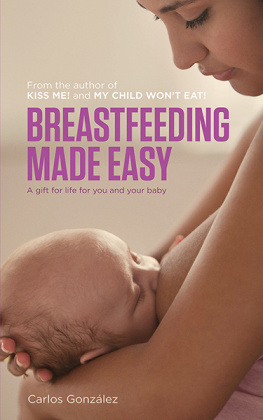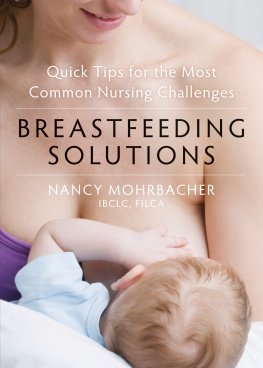THE HARVARD COMMON PRESS
535 Albany Street
Boston, Massachusetts 02118
www.harvardcommonpress.com
Copyright 2007 by Kathleen Huggins and Linda Ziedrich
Illustrations copyright 2007 by Susan Aldridge
All rights reserved. No part of this publication may be reproduced or
transmitted in any form or by any means, electronic or mechanical,
including photocopying, recording, or any information storage or
retrieval system, without permission in writing from the publisher.
Printed in the United States of America
Printed on acid-free paper
Library of Congress Cataloging-in-Publication Data
Huggins, Kathleen.
The nursing mother's guide to weaning : how to bring breastfeeding to a
gentle close and how to decide when the time is right / by Kathleen
Huggins and Linda Ziedrich.2nd ed.
p. cm.
Includes bibliographical references and index.
ISBN 1-55832-352-X (pbk. : alk. paper)
1. InfantsWeaning. I. Ziedrich, Linda. II. Title.
RJ216.H8453 2006
649'.122dc22
2006026174
ISBN-13: 978-1-55832-352-0
ISBN-10: 1-55832-352-X
Special bulk-order discounts are available on this and other
Harvard Common Press books. Companies and organizations may
purchase books for premiums or resale, or may arrange a custom
edition, by contacting the Marketing Director at the address above.
BOOK DESIGN BY JILL WEBER
ILLUSTRATIONS BY SUSAN ALDRIDGE
10 9 8 7 6 5 4 3 2 1
To the children we have nursed and weaned:
Kate, John, Ben, Rebecca, and Sam
Foreword
W E HAVE A SIGN IN OUR OFFICE that reads, "Early weaning is not recommended for babies." Although timely weaning is the ideal, we realize that the ideal is not achievable for many families. Weaning is not a negative term. It does not mean a loss or detachment from a relationship, but rather a passage from one relationship to another. Our first three infants were weaned before their time. We were young and uninformed parents. We misread our babies' cues, lacked confidence in our own intuitions, and yielded to the norms of the neighborhood. We were able to give our later babies their rightful heritage, and not wean them before their time.
In ancient writings the word wean meant "to ripen"like fruit ripened to readiness, until it's time to leave the vine. A child's weaning was a festive occasion, and not because of what you might think"Now I can finally get away from this kid." Weaning was a joyous occasion because a weaned child was valued as a fulfilled child, a child so well equipped with the basic tools of the earlier stages of development that she had graduated to take on the next stage of development more independently. A child who is weaned before her time enters the next stage of development more anxiously and is consequently less prepared for its challenges and less ready for its independence.
An insightful mention of weaning is found in the writings of King David: "I have stilled and quieted my soul; like a weaned child with its mother, like weaned child is my soul within me." The psalmist David equates his feeling of peace and tranquility with the feeling of fulfillment that a weaned child has with his mother. In ancient times, and in many societies today, a baby is breastfed for two to three years.Westerners are accustomed to thinking of breastfeeding in terms of months. We would like parents to think of breastfeeding in terms of years. As Dr. Antonia Novello, the past U.S. Surgeon General, commented, "It's the lucky baby, I feel, who continues to nurse until he's two."
Life is a series of weanings for a child: weaning from the womb, weaning from the breast, weaning from home to school, and from school to work. An infant or child who is weaned from these places of security before he is filled at one stage and ready to take on the next is at risk for developing what we call diseases of premature weaning: anger, aggression, and generally disorganized behavior. Over our 38 years of experience in dealing with families, the healthiest children we have seen are those who are not weaned before their time. Kathleen Huggins and Linda Ziedrich make these points (and many more) beautifully throughout this book.
W ILLIAM AND M ARTHA S EARS
Authors of The Baby Book
Introduction
W HAT DOES IT MEAN TO WEAN A CHILD? Wean is a very old word meaning to accustom a child to a loss of her mother's milk. But today the word is usually used metaphorically; we wean ourselves from television watching, for instance, or from some other habit. The original meaning of the word is getting lost in an age when most babies, at too young an age to protest much, are simply given the bottle instead of the breast. Since this practice seems safe enough, and often easy, few of us understand weaning as the great and dangerous passage it is known to be in most of the world's societies. But when we ignore the dangers and difficulties of weaning, we risk our children's well-being, and sometimes our own.
Scientists have done little to enlighten us on the subject of weaning. Most are confused about how to define the term: Does weaning mean introducing foods other than breast milk into a child's diet, or does it mean stopping breastfeeding altogether? Some writers have assumed that the two events occur at once, but only in Western society has this been so, and only since the advent of factory-produced foods. Other writers have assumed that women in traditional societies were weaning when they gave their babies small amounts of ritual or medicinal foods. Some researchers have written treatises on weaning that concern only giving up the bottle, and don't even mention the breast. Some physicians and nutritionists have tried to generalize about all mothers and babies from studies of malnourished mothers and weanlings in countries suffering from Western colonization and industrialization. Psychologists and psychiatrists have insisted that weaning methods largely determine personality, and a few have actually compared adults who were weaned in the early months with those weaned later, finding the early weaners to be pessimistic, aloof, insecure, and unhelpful (Goldman 1948, Slome 1960). Generally, though, psychological and psychiatric writings on weaning are almost entirely speculative.
Anthropologists, including Margaret Mead, have probably been most helpful in developing our understanding of weaning. They have found that women wean at the time and in the way that their cultures prescribe, and that peaceful, cooperative societies tend to have longer breastfeeding periods and gentler weaning methods. Anthropologists haven't demonstrated, however, a cause-and-effect relationship between the way a child is weaned and her later personality. Few scientists of any sort have examined how weaning affects children's minds, either immediately or in the long term. Nor have scientists considered how weaning affects mothers' mindsor their bodies, for that matter.
Weaning methods and ages vary greatly among traditional societies. In some, women don't initiate the close of breastfeeding at all, but let their children go on nursing as long as they likefor as long as fifteen years (Wickes 1953). In other societies, breastfeeding ends in the second year or even earlier, and children may be scolded, slapped, teased, and frightened into leaving their mothers' breasts alone. But both of these examples are extremes. In most societies, mothers don't begin to work at weaning before the child is between two and three years old, and if weaning is abrupt it is also without cruelty (Whiting and Child 1953, 71). The median age of complete weaning worldwide has been variously estimated as between three and five years.
Western confusion about weaning stems partly from the fact that our heterogeneous society has no rules about when and how to wean. In the 1960s it seemed that weaning from the breast would soon no longer be an issue at allbottle feeding from birth was apparently becoming universal in our society. Since the mid-1970s, however, a far greater proportion of mothers have breastfed, many for longer periods than their great-grandmothers did. Although many women today wean in the first few weeks after birth, often in preparation for a return to work, others nurse for two years, three years, four years, or longer. Preferences about breastfeeding and weaning vary by class, region, and family, but these variations aren't absolute; they are only statistical. Every woman must decide for herself what is best for her and her child.
Next page
